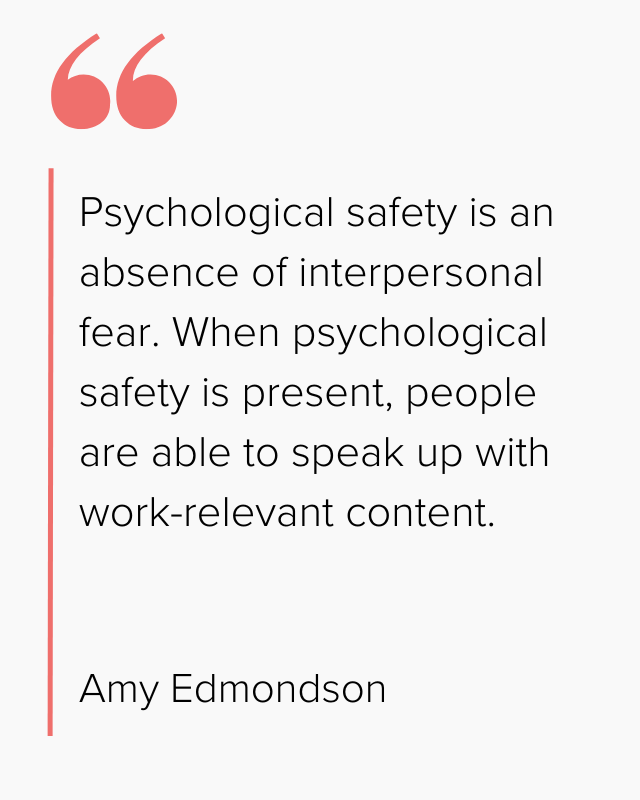How do you build a workforce that is 76% more engaged, 50% more productive, and 67% more likely to apply newly-learned skills on the job?
Start by creating a psychologically safe environment.
Psychological safety plays a pivotal role in fostering a positive and high-performing culture. In psychologically safe environments, employees feel encouraged to take risks, share their thoughts openly, and be vulnerable without fear of negative consequences. When nurtured, this environment empowers employees to collaborate, innovate, and contribute their best work.
As HR professionals, understanding and enhancing psychological safety within the workplace is paramount.
And a psychological safety survey can help you do just that.
TABLE OF CONTENTS
- 1. What is psychological safety in the workplace?
- 2. Impact of psychological safety on employee well-being and performance
- 3. What is a psychological safety survey?
- 4. Benefits of conducting psychological safety surveys
- 5. Key components of a psychological safety survey
- 6. Psychological safety survey sample questions
What is psychological safety in the workplace?

Psychological safety is a phrase coined by respected researcher Amy Edmondson in a 1999 report on learning behavior in work teams. In Edmondson’s own words, psychological safety is defined as “a shared belief held by members of a team that the team is safe for interpersonal risk taking.”
This means that a psychologically safe workplace is an environment where trust, respect, and open communication are nurtured. Here, employees feel confident that they can share their thoughts, concerns, and even admit mistakes without fear of ridicule or punishment.
A workplace with a high level of psychological safety encourages learning and growth, embraces diversity and inclusion, and prioritizes employee well-being. In such a setting, individuals are more willing to step out of their comfort zones, explore new ideas, and work together as a cohesive team.
Impact of psychological safety on employee well-being and performance
The influence of psychological safety on employee well-being and performance cannot be overstated.
When employees feel psychologically safe, they experience reduced stress and anxiety, leading to increased job satisfaction and improved mental health. A sense of safety also fosters a healthier work-life balance, allowing employees to bring their best selves to work each day.
- Reduced stress and anxiety: In a psychologically safe workplace, employees are not constantly worried about judgment or punishment, resulting in reduced stress levels and a healthier work environment. In fact, one study revealed that employees that have high psychological safety experience 74% less stress.
- Increased job satisfaction: When employees feel safe and supported, they are more likely to be satisfied with their jobs. This satisfaction translates into 76% more engagement and a 27% reduction in turnover.
- Improved mental health: Psychological safety positively impacts mental health, as employees are less likely to experience feelings of isolation or fear of rejection. Surveys show that employees at high-trust companies experience 106% more energy at work and experience 29% more satisfaction with their lives.
By creating a psychologically safe workplace, organizations can tap into the full potential of their employees. When individuals feel safe and valued, they are more likely to take risks, collaborate, and contribute to the organization’s success.
What is a psychological safety survey?
A psychological safety survey is a tool designed to assess and measure the level of psychological safety within an organization.
It allows HR professionals and leadership teams to gain valuable insights into the employees’ perceptions of the work environment and identify areas that may require attention. These surveys typically include a set of questions related to various aspects of psychological safety, encouraging employees to provide honest and constructive feedback anonymously.
Benefits of conducting psychological safety surveys
Conducting psychological safety surveys offer several key advantages:
- Insight into employees’ experiences: Surveys provide a direct line of communication with employees, giving them the opportunity to voice their thoughts and feelings without fear of repercussions. This helps organizations understand the workforce’s concerns and challenges.
- Identifying areas for improvement: Psychological safety surveys help identify specific areas where the organization may need to improve its culture and practices. By pinpointing these areas, HR professionals can develop targeted, data-driven interventions.
- Quantifying psychological safety: Surveys provide a quantifiable measurement of psychological safety. This data allows organizations to track progress over time and set benchmarks for improvement.
- Benchmarking and comparison: Comparing survey results across teams, departments, or demographics can highlight disparities in psychological safety. This information can guide efforts to establish best practices and support those who may be struggling.
Why overpay for employee feedback?
Understand your employee experience at every step of their journey from onboarding to exit with JobSage Retain— all for an affordable $100 per month.
Key components of a psychological safety survey
To effectively gauge psychological safety, a well-designed survey should incorporate several key components.
1. Anonymity and confidentiality
Anonymity in the survey responses is vital to encourage employees to share their genuine thoughts without fear of retaliation. Ensuring confidentiality reinforces trust in the survey process. When employees know that their responses are anonymous and won’t be traced back to them, they are more likely to provide honest and candid feedback. This allows HR professionals and leaders to gain a more accurate understanding of the prevailing sentiments within the organization.
2. Metrics and rating scales
Including quantitative metrics and rating scales helps in quantifying the level of psychological safety, making it easier to track progress over time and compare results.
Rating scales, such as Likert scales, can assess the strength of agreement or disagreement with statements related to psychological safety. These metrics offer valuable data for HR professionals to analyze trends and changes in psychological safety levels and identify areas that need improvement.
3. Open-ended questions
Open-ended questions provide employees with the opportunity to express themselves freely, enabling HR professionals to gain deeper insights into the employees’ experiences and concerns. These questions allow respondents to share their thoughts in their own words, providing rich qualitative data that complements the quantitative metrics.
4. Frequency and timing of surveys
Conducting surveys at regular intervals allows organizations to monitor changes in psychological safety over time.
The timing of the survey should be strategic, taking into account any recent organizational changes or events that could influence responses. That said, organizations are always going through changes. At some point, you must just agree on a date and conduct the survey in order to get a baseline. An annual or semi-annual survey may be appropriate to track progress and identify long-term trends.
Additionally, conducting surveys during or after significant organizational events, such as leadership changes or major projects, can provide insights into how these events impact psychological safety.
Psychological safety survey sample questions
Designing a psychological safety survey with thoughtful and relevant questions is crucial to obtain valuable insights into employees’ perceptions and experiences within the workplace.
Below are some sample questions that can be included in a psychological safety survey:
1. Trust and respect
- Do you feel comfortable sharing your opinions and ideas with your immediate supervisor or manager?
- Are you confident that your contributions are valued and appreciated within the team?
- Do you believe that your colleagues treat each other with respect and empathy?
2. Open communication
- Do you feel encouraged to speak up when you notice potential issues or areas for improvement in the work processes?
- Are you confident that your concerns and feedback will be actively listened to and taken into consideration?
- How comfortable do you feel giving constructive feedback to your peers and superiors?
3. Psychological safety support
- Do you feel supported by your team members when you take on new challenges or risks in your role?
- Are you confident that seeking help or admitting mistakes will not lead to negative consequences?
- Do you believe that the organization provides resources and support for your mental well-being?
4. Inclusion and belonging
- Do you feel that your unique perspectives and experiences are appreciated and acknowledged in the workplace?
- Do you believe that diversity is valued and celebrated within the organization?
- Are you comfortable being yourself at work, regardless of your background or identity?
5. Feedback and recognition
- How frequently do you receive positive feedback from your supervisor or manager regarding your performance?
- How frequently do you receive constructive feedback from your supervisor or manager regarding your performance?
- Do you feel that your achievements are adequately recognized and appreciated?
- Do you feel that your daily contributions are adequately recognized and appreciated?
- Are you satisfied with the feedback mechanisms in place within the organization?
- Are you satisfied with the recognition mechanisms in place within the organization?
6. Psychological safety in decision-making
- Do you feel comfortable challenging decisions made by leadership when you disagree with them?
- Are you involved in decision-making processes that affect your work?
- Are you involved in decision-making processes that affect your team?
- How confident are you that your opinions are taken into account when decisions about your work are made?
7. Leadership and support
- How effective do you perceive the leadership team in fostering a psychologically safe work environment?
- Are leaders approachable and open to feedback from employees?
- How well do leaders exemplify the values of psychological safety in their own behavior?
A better workplace for all
Psychological safety stands as the cornerstone of a healthy and successful work environment. It empowers employees to express themselves, collaborate openly, and embrace continuous growth. As HR professionals, recognizing the significance of psychological safety and its impact on employee well-being and performance allows us to champion positive change within our organizations.
Psychological safety surveys act as invaluable tools to assess, monitor, and strengthen the workplace culture. By carefully crafting questions that delve into trust, communication, inclusivity, and support, HR professionals can gain profound insights into the dynamics of their workforce. Armed with this knowledge, they can tailor interventions and strategies to address specific challenges and foster a culture of psychological safety.
